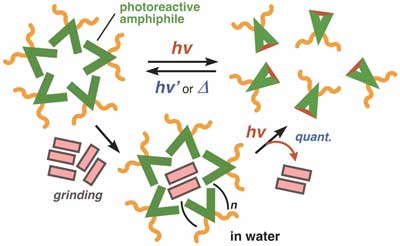| Apr 24, 2019 | |
Nanosized container with photoswitches: release of cargo upon irradiation in water(Nanowerk News) Researchers at Tokyo Tech's Laboratory for Chemistry and Life Science have developed a micelle-type nano-container that can be switched between its assembled and disassembled state via simple light irradiation. The light stimulus induces a structural change in the amphiphilic subunits, which closes their integrated binding pocket and simultaneously results in disassembly (see Figure 2). |
|
| In a recent publication in Nature Communications ("Polyaromatic nanocapsules as photoresponsive hosts in water"), Lorenzo Catti (JSPS/Humboldt postdoctoral fellow), Natsuki Kishida, Michito Yoshizawa and co-workers successfully demonstrates how to combine the use of water and light, both essential ingredients for life, in an environmentally benign delivery system. | |
 |
|
| Figure 1: Schematic representation of guest uptake via grinding and release of the guest upon irradiation in water. The container can be regenerated by light irradiation or heating. (Image: Tokyo Tech) | |
| "Water and light are abundant and clean resources on earth," Dr. Yoshizawa says. "Active use of both of them in synthetic and materials chemistry has seldom been accomplished so far but is and urgent necessity for the development of sustainable modern technologies". | |
| The achievement is grounded on a small design change in the subunit of the nanosized container. By moving the two polyaromatic (Polyaromatic: Planar molecular structure composed of several bezene rings fused together) panels on a previous amphiphilic compound (Figure 2, left) one carbon atom closer together, the authors enabled a photochemical reaction between the panels that results in quantitative closing of the binding pocket (Figure 2, right). | |
| In addition, the group could show that this reaction is partially and fully reversible by light irradiation and heating, respectively. | |
| The study is part of the groups ongoing effort towards environmentally benign nanoflask systems with controllable functionality. The new system can be considered an "aromatic micelle", a concept that was introduced by the group in 2013. | |
 |
|
| Figure 2: Chemical structures of the previous (left) and new amphiphile (right). Light irradiation induces a structural change from the open to the closed form of the amphiphile. (Image: Tokyo Tech) | |
| Uptake of water-insoluble guest molecules into the container was shown to be easily achievable via a simple grinding protocol. Addition of water to the resulting solids gave characteristically colored solutions, which displayed UV-visible absorption bands assignable to the bound guest molecules. The flexible character of the nano-container allowed the uptake of a wide variety of compounds, such as rod-shaped and planar dyes and spherical fullerenes, in water. | |
| Quantitative release of the guest compounds could be achieved via irradiation of the aqueous solution for 10 min at room temperature. The released, water-insoluble guests could furthermore be successfully recovered via simple filtration, giving rise to a clear colorless solution containing only the closed amphiphiles. | |
| "In a biomedical context, the developed system holds great promise for future progress in non-invasive delivery of biomolecules and synthetic drugs," Dr. Yoshizawa concluded. Future improvements of the system are aimed at allowing a weaker light source for irradiation, which will bring the system one step closer to the envisioned in-vivo delivery application. |
| Source: Tokyo Institute of Technology | |
|
Subscribe to a free copy of one of our daily Nanowerk Newsletter Email Digests with a compilation of all of the day's news. |
